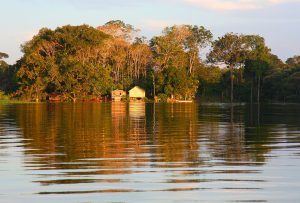80 Latin America and the Caribbean (LACAR): Population Geography II – Brazil as a Top Five Country
Brazil is a huge country that ranks highly in many different categories. Let’s take a look at Brazil’s Top Five rankings.
First of all, for nearly three decades Brazil stood fifth in the world in total population. Whereas China and India both have over 1.3 billion people, far ahead of any other countries, Brazil houses 212 million people in 2020. Upon the breakup of the Soviet Union and Russia’s corresponding drop out of the top five countries by population, Brazil took over fifth place. However, Brazil’s total fertility rate has been declining for a number of years, so that Brazil’s hold on fifth place did not last. Pakistan now has passed Brazil for fifth place. Additionally, Nigeria is slated to pass Brazil, at least by 2030. In fact, some sources suggest that Nigeria already has passed Brazil; however, with the vagaries of calculating population size, especially in a dynamic country like Nigeria, it is difficult to gain a precise count. Nigeria is increasing rapidly, so while Brazil has a birth rate of 13.6 and a death rate of 6.6, Brazil’s natural population increase this year should be about 0.7%, definitely lower than that of Nigeria.
Due to the Treaty of Tordesillas of 1494, Portugal secured territorial rights to Brazil. Although Brazil gained independence in 1822, the Portuguese language has remained its official language through the current day. Portugal has ten million people speaking Portuguese. People in its former colonies do speak Portuguese as well – 30 million in Angola, 27 million in Mozambique, and a scattered several million elsewhere. Obviously then, Brazil is the most populated country that speaks Portuguese.

Second, Brazil holds the fifth most area in the world with a bit under 3.3 million square miles. This fifth position will hold for the foreseeable future, as change would require land losses or acquisitions by war or treaty. Changes such as these are very unlikely.
This large area naturally has major landscape features. For Brazil, the most obvious is the Amazon Rainforest that is the largest forest in the world. The corresponding Amazon River is the largest in the world in terms of volume of discharge. While some cite the Amazon as the longest river in the world, most commonly the Nile River is considered #1 and the Amazon #2 in length.

Brazil’s vast area also is productive for agriculture, though there are significant environmental concerns over the destruction of rainforest for conversion into crop fields or grazing land. In any case Brazil’s farmland is productive, leading to large volumes of agricultural exports. Brazil is famed for coffee, rightly so, for it is the world’s largest producer and exporter of coffee, accounting for 30% of the planet’s coffee market. Coffee is not Brazil’s only huge contribution to the Earth’s beverage supply. As with coffee, orange juice ranks #1 worldwide in production in and export from Brazil.
In other crops Brazil scores a Top Five ranking, including cane sugar, soybeans, corn, cotton, and tobacco. Sugar cane also is used for the production of ethanol fuels, where again Brazil ranks number one in the world.
Significant agricultural lands are used for grazing herds, not just for growing crops. In Brazil the total head of beef cattle nearly matches the number of people in the country. Across the globe, Brazil is the number one exporter of beef and chicken.
Brazil’s large territory contains a variety of natural resources. In worldwide exports, Brazil ranks #2 in iron ore, #3 in bauxite (for aluminum), and #5 in tin.
Additionally, Brazil has the second greatest amount of installed hydroelectric capacity.
In an unfortunate new category, as of June 13, 2020, Brazil ranked #2 in total numbers of COVID-19 deaths, surpassing the United Kingdom, but trailing the United States by a wide margin.
Overall, Brazil #5 area gives it enough land to excel in the production of a variety of agricultural products and natural resources. The country’s #5 population provides enough people to do the work to propel Brazil’s exports.
Did You Know?
Brazilian steakhouses such as Fogo de Chão have gained considerable popularity across the United States, particularly in larger cities and in Texas.
Considering adventure tourism, US News and World Report ranks Brazil as the world’s number one adventure destination.
Cited and additional bibliography:
“Brazil Population (2019) – Worldometers.” 2019. Worldometers.Info. 2019. https://www.worldometers.info/world-population/brazil-population/.
“Brazil’s Main Agricultural Products and Exports.” 2020. Www.4property.Uk.Com. 2020. https://www.4property.uk.com/brazil/main-agricultural-products-and-exports/.
Jones, Jennifer. 2018. “10 Largest Forests in the World.” Largest.Org. November 27, 2018. https://largest.org/nature/forests/.
Pines, Lawrence. 2018. “Brazil’s Top Commodity Imports &…” Commodity.Com. Commodity Trading. September 28, 2018. https://commodity.com/brazil/.
“The Best Countries for Adventure, Ranked.” 2020. Usnews.Com. 2020. https://www.usnews.com/news/best-countries/adventure-rankings.


